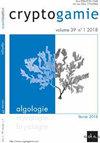标题西伯利亚东北部沙棘属新罕种(硅藻门,沙棘科)
IF 1.5
4区 生物学
Q3 MARINE & FRESHWATER BIOLOGY
引用次数: 5
摘要
摘要最近在俄罗斯西伯利亚东北部的湖泊中发现了三种罕见的沙棘。其中一种在科莱马低地的湖泊中发现的物种,在科学上是新的,在这里正式描述为Psammothidium onufrii sp. 11 .它在形态上与咸水物种Achnanthes punctulata相似,但它在无缝瓣上缺乏一个中心区域,而在缝瓣上有一个很大的中心区域。沙尘是冻土带热岩溶湖泊的特征,矿物含量适中。在科雷马低地和马加丹地区的几个湖泊中发现了以前报道的几个亚北极和北极地区的沙棘。本文首次记录了该物种的节肢超微结构。第三种硅藻,被称为Achnanthes obliqua (W. Gregory) Hustedt,并在这里转移到Psammothidium,是一种形态独特且相对罕见的硅藻,偶尔报道来自欧亚大陆北部地区和北美西部。在西伯利亚东北部,它被发现在相对较大的浅湖沉积物中,矿物质含量低至中等。对三种沙棘进行详细的形态鉴定,将有助于其在环境调查中的发现和古环境重建中的应用。本文章由计算机程序翻译,如有差异,请以英文原文为准。
New and Rare Psammothidium Species (Bacillariophyta, Achnanthidiaceae) from Northeastern Siberia
Abstract
Three rare Psammothidium species were found in recently surveyed lakes of Northeastern Siberia, Russia. One of these species found in lakes of the Kolyma Lowland, is new for science and is formally described here as Psammothidium onufrii sp. nov. It is morphologically similar to the brackish–water species Achnanthes punctulata, but it lacks a central area on rapheless valve and possesses a large central area on the raphe valve. Psammothidium onufrii is characteristic for tundra thermokarst lakes with moderate mineral content. Psammothidium sacculum previously reported from a few subarctic and arctic locations was found in several lakes of the Kolyma Lowland and of the Magadan District. The frustule ultrastructure of this species is documented for the first time here. The third species, known as Achnanthes obliqua (W. Gregory) Hustedt and transferred here to Psammothidium, is a morphologically distinct and relatively rare diatom occasionally reported from northern regions of Eurasia and Western North America. In Northeastern Siberia it was found in sediments of relatively large shallow lakes with low to moderate mineral content. Detailed morphological characterization of the three Psammothidium species will facilitate their detection in environmental surveys and their use in paleoenvironmental reconstructions.
求助全文
通过发布文献求助,成功后即可免费获取论文全文。
去求助
来源期刊

Cryptogamie Algologie
生物-海洋与淡水生物学
CiteScore
2.60
自引率
7.70%
发文量
11
审稿时长
>12 weeks
期刊介绍:
Cryptogamie is a fast-track and peer-reviewed journal of international scope publishing in English only. It accepts original papers and review articles on the taxonomy, biology and ecology of all cryptogams. An issue of Cryptogamie may be devoted to a single topic, under the responsibility of guest editor(s). All articles published in Cryptogamie are compliant with the different nomenclatural codes. A copyright assignment will be signed by the authors before publication.
Cryptogamie, Algologie accepts articles on systematics as well as ecology and evolution of any kind of algae (including Cyanobacteria).
 求助内容:
求助内容: 应助结果提醒方式:
应助结果提醒方式:


